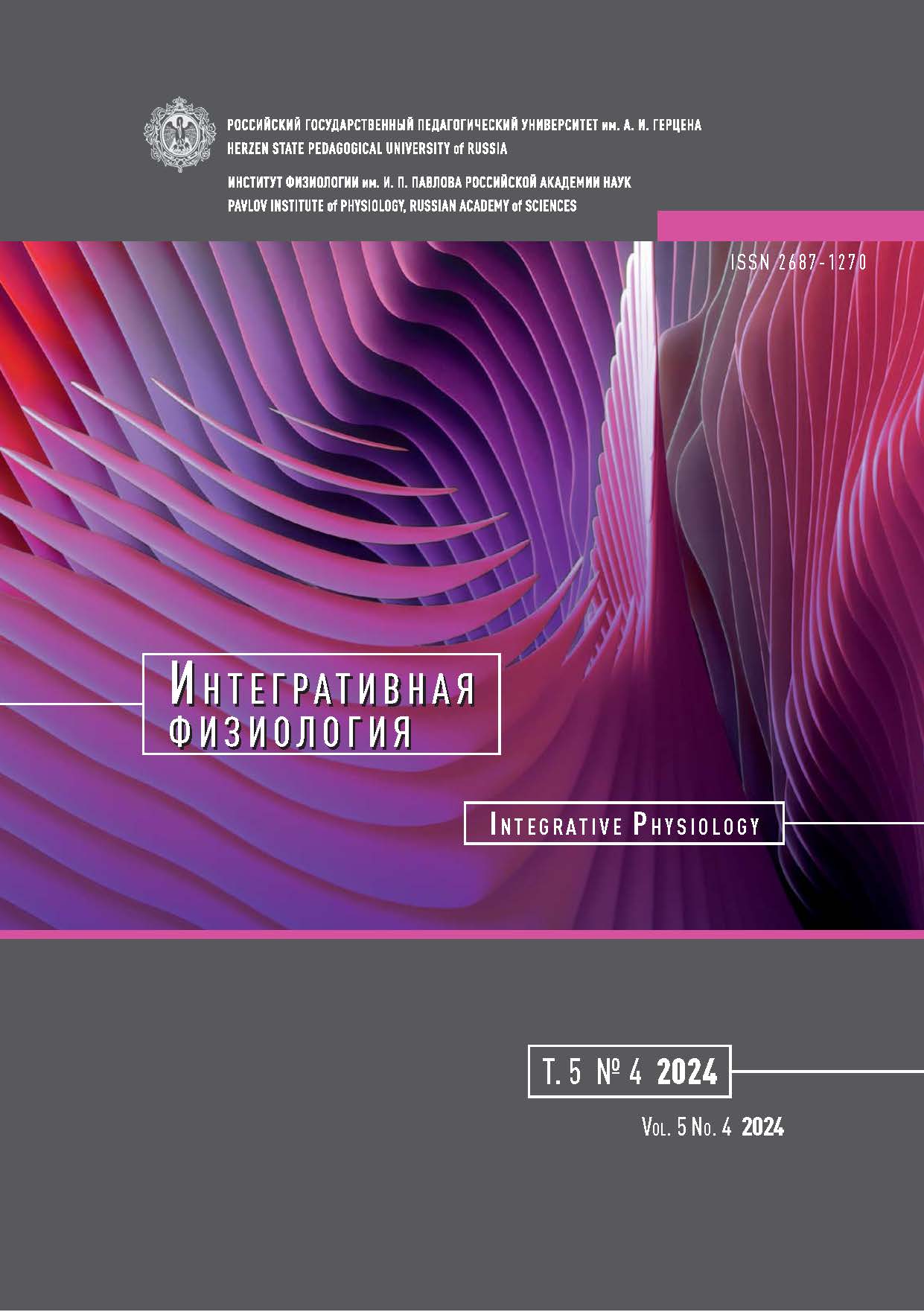Изменения тета- и альфа-активности у пациентов с сосудистым когнитивным расстройством, прошедших когнитивную реабилитацию после коронарного шунтирования
DOI:
https://doi.org/10.33910/2687-1270-2024-5-4-345-356Ключевые слова:
сосудистые когнитивные расстройства, когнитивный тренинг, ЭЭГ, тета-ритм, альфа-ритм, коронарное шунтированиеАннотация
Нарушения мозговой перфузии, вызванные атеросклерозом или кардиохирургическим вмешательством, ассоциированы с когнитивными расстройствами (КР). Поиск и внедрение эффективных методов профилактики КР требуют контроля нейрофизиологических изменений, которые сопровождают реабилитационный процесс. В работе изучены изменения тета- и альфа-активности коры головного мозга у пациентов с наличием и отсутствием сосудистого когнитивного расстройства (СКР), прошедших в раннем послеоперационном периоде коронарного шунтирования (КШ) когнитивную реабилитацию. В исследовании принимали участие 104 пациента, 51 из них в раннем послеоперационном периоде КШ прошли курс комбинированного мультизадачного тренинга, 53 пациента составили группу сравнения. Признаки СКР у пациентов обеих групп выявляли перед проведением КШ с использованием модифицированной русскоязычной версии Монреальской шкалы когнитивной оценки (Montreal Cognitive Assessment (MoCA). Электроэнцефалографическое (ЭЭГ) исследование проводили в состоянии спокойного бодрствования с закрытыми глазами за три–пять дней до КШ и на 11–12-е сутки после операции. Установлено, что у пациентов без СКР, прошедших тренинг, отсутствует увеличение тета-активности после КШ по сравнению с пациентами с наличием СКР (p = 0,017). В группе контроля увеличение тета-активности после КШ наблюдается вне зависимости от наличия СКР. В работе продемонстрировано неблагоприятное влияние СКР на изменения мозговой активности в процессе когнитивной реабилитации. Необходимо продолжить исследования для изучения нейрофизиологических механизмов восстановления когнитивных функций после кардиохирургических операций.
Библиографические ссылки
ЛИТЕРАТУРА
Ивкин, А. А., Григорьев, Е. В., Шукевич, Д. Л. (2021) Роль искусственного кровообращения в развитии послеоперационной когнитивной дисфункции. Кардиология и сердечно-сосудистая хирургия, т. 14, № 2, с. 168–174. https://doi.org/10.17116/kardio202114021168
Катунина, Е. А. (2015) Гетерогенность сосудистых когнитивных нарушений и вопросы терапии. Неврология, нейропсихиатрия, психосоматика, т. 7, № 3, с. 62–69. https://doi.org/10.14412/2074-2711-2015-3-62-69
Локшина, А. Б., Гришина, Д. А., Захаров, В. В. (2023) Сосудистые когнитивные нарушения: вопросы диагностики и лечения. Неврология, нейропсихиатрия, психосоматика, т. 15, № 2, с. 106–113. https://doi.org/10.14412/2074-2711-2023-2-106-113
Парфенов, В. А. (2017) Сосудистые когнитивные нарушения. В кн.: Дисциркуляторная энцефалопатия и сосудистые когнитивные расстройства. М.: ИМА-ПРЕСС, с. 23–26.
Тарасова, И. В., Тарасов, Р. С., Трубникова, О. А. и др. (2020a) Изменения электрической активности головного мозга у пациентов с различной тяжестью поражения коронарного русла через один год после коронарного шунтирования. Комплексные проблемы сердечно-сосудистых заболеваний, т. 9, № 1, с. 6–14. https://doi.org/10.17802/2306-1278-2020-9-1-6-14
Тарасова, И. В., Трубникова, О. А., Разумникова, О. М. (2020b) Пластичность функциональных систем мозга как компенсаторный ресурс при нормальном и патологическом старении, ассоциированном с атеросклерозом. Атеросклероз, т. 16, № 1, с. 59–67. https://doi.org/10.15372/ATER20200108
Трубникова, О. А., Тарасова, И. В., Барбараш, О. Л. (2020) Нейрофизиологические механизмы и перспективы использования двойных задач в восстановлении когнитивных функций у кардиохирургических пациентов. Фундаментальная и клиническая медицина, т. 5, № 2, c. 101–111. https://doi.org/10.23946/2500-0764-2020-5-1-101-111
Трубникова, О. А., Тарасова, И. В., Кухарева, И. Н. и др. (2022) Эффективность компьютеризированных когнитивных тренингов методом двойных задач в профилактике послеоперационных когнитивных дисфункций при коронарном шунтировании. Кардиоваскулярная терапия и профилактика, т. 21, № 8, статья 3320. https://doi.org/10.15829/1728-8800-2022-3320
Babiloni, C., Blinowska, K., Bonanni, L. et al. (2020) What electrophysiology tells us about Alzheimer’s disease: A window into the synchronization and connectivity of brain neurons. Neurobiology of Aging, vol. 85, pp. 58–73. https://doi.org/10.1016/j.neurobiolaging.2019.09.008
Babiloni, C., Ferri, R., Noce, G. et al. (2021) Resting state alpha electroencephalographic rhythms are differently related to aging in cognitively unimpaired seniors and patients with Alzheimer’s Disease and amnesic mild cognitive impairment. Journal of Alzheimer’s Disease, vol. 82, no. 3, pp. 1085–1114. https://doi.org/10.3233/JAD-201271
Brain, J., Greene, L., Tang, E. Y. H. et al. (2023) Cardiovascular disease, associated risk factors, and risk of dementia: An umbrella review of meta-analyses. Frontiers in Epidemiology, vol. 3, article 1095236. https://doi.org/10.3389/fepid.2023.1095236
Chang Wong, E., Chang Chui, H. (2022) Vascular cognitive impairment and dementia. Continuum: Lifelong Learning in Neurology, vol. 28, no. 3, pp. 750–780. https://doi.org/10.1212/CON.0000000000001124
Estarellas, M., Huntley, J., Bor, D. (2024) Neural markers of reduced arousal and consciousness in mild cognitive impairment. International Journal of Geriatric Psychiatry, vol. 39, no. 6, article e6112. https://doi.org/10.1002/gps.6112
Fernández, A., Noce, G., Del Percio, C. et al. (2022) Resting state electroencephalographic rhythms are affected by immediately preceding memory demands in cognitively unimpaired elderly and patients with mild cognitive impairment. Frontiers in Aging Neuroscience, vol. 14, article 907130. https://doi.org/10.3389/fnagi.2022.907130
Hachinski, V. (1994) Vascular dementia: A radical redefinition. Dementia, vol. 5, no. 3-4, pp. 130–132. https://doi.org/10.1159/000106709
Hamilton, C. A., Schumacher, J., Matthews, F. et al. (2021) Slowing on quantitative EEG is associated with transition to dementia in mild cognitive impairment. International Psychogeriatrics, vol. 33, no. 12, pp. 1321–1325. https://doi.org/10.1017/S1041610221001083
Iliadou, P., Paliokas, I., Zygouris, S. et al. (2021) A comparison of traditional and serious game-based digital markers of cognition in older adults with mild cognitive impairment and healthy controls. Journal of Alzheimer’s Disease, vol. 79, no. 4, pp. 1747–1759. https://doi.org/10.3233/JAD-201300
Jafari, Z., Kolb, B. E., Mohajerani, M. H. (2020) Neural oscillations and brain stimulation in Alzheimer’s disease. Progress in Neurobiology, vol. 194, article 101878. https://doi.org/10.1016/j.pneurobio.2020.101878
Kasputytė, G., Bukauskienė, R., Širvinskas, E. et al. (2023) The effect of relative cerebral hyperperfusion during cardiac surgery with cardiopulmonary bypass to delayed neurocognitive recovery. Perfusion, vol. 38, no. 8, pp. 1688–1696. https://doi.org/10.1177/02676591221129737
Moretti, D. V. (2015) Theta and alpha EEG frequency interplay in subjects with mild cognitive impairment: Evidence from EEG, MRI, and SPECT brain modifications. Frontiers in Aging Neuroscience, vol. 7, article 31. https://doi.org/10.3389/fnagi.2015.00031
Musaeus, C. S., Engedal, K., Høgh, P. et al. (2018) EEG theta power is an early marker of cognitive decline in dementia due to Alzheimer’s disease. Journal of Alzheimer’s Disease, vol. 64, no. 4, pp. 1359–1371. https://doi.org/10.3233/JAD-180300
Park, J., Ho, R. L. M., Wang, W.-E. et al. (2024) The effect of age on alpha rhythms in the human brain derived from source localized resting-state electroencephalography. NeuroImage, vol. 292, article 120614. https://doi.org/10.1016/j.neuroimage.2024.120614
Prieto Del Val, L., Cantero, J. L., Atienza, M. (2016) Atrophy of amygdala and abnormal memory-related alpha oscillations over posterior cingulate predict conversion to Alzheimer’s disease. Scientific Reports, vol. 6, article 31859. https://doi.org/10.1038/srep31859
Rollnik, J. D. (2019) Clinical neurophysiology of neurologic rehabilitation. Handbook of Clinical Neurology, vol. 161, pp. 187–194. https://doi.org/10.1016/B978-0-444-64142-7.00048-5
Sheorajpanday, R. V. A., Marien, P., Weeren, A. J. T. M. et al. (2013) EEG in silent small vessel disease: SLORETA mapping reveals cortical sources of vascular cognitive impairment no dementia in the default mode network. Journal of Clinical Neurophysiology, vol. 30, no. 2, pp. 178–187. https://doi.org/10.1097/WNP.0b013e3182767d15
Steinberg, N., Parisi, J. M., Feger, D. M. et al. (2023) Rural-urban differences in cognition: Findings from the advanced cognitive training for independent and vital elderly trial. Journal of Aging and Health, vol. 35, no. 9, suppl., pp. 107S–118S. https://doi.org/10.1177/08982643221102718
Tarasova, I. V., Kukhareva, I. N., Kupriyanova, D. S. et al. (2024) Electrical activity changes and neurovascular unit markers in the brains of patients after cardiac surgery: Effects of multi-task cognitive training. Biomedicines, vol. 12, no. 4, article 756. https://doi.org/10.3390/biomedicines12040756
Tarasova, I. V., Trubnikova, O. A., Barbarash, O. L. (2018) EEG and clinical factors associated with mild cognitive impairment in coronary artery disease patients. Dementia and Geriatric Cognitive Disorders, vol. 46, no. 5-6, pp. 275–284. https://doi.org/10.1159/000493787
Tarasova, I. V., Trubnikova, O. A., Kukhareva, I. N. et al. (2023) A comparison of two multi-tasking approaches to cognitive training in cardiac surgery patients. Biomedicines, vol. 11, no. 10, article 2823. https://doi.org/10.3390/biomedicines11102823
Torres-Simón, L., Doval, S., Nebreda, A. et al. (2022) Understanding brain function in vascular cognitive impairment and dementia with EEG and MEG: A systematic review. NeuroImage. Clinical, vol. 35, article 103040. https://doi.org/10.1016/j.nicl.2022.103040
Wang, Y., Zhang, H., Liu, L. et al. (2023) Cognitive function and cardiovascular health in the elderly: Network analysis based on hypertension, diabetes, cerebrovascular disease, and coronary heart disease. Frontiers in Aging Neuroscience, vol. 15, article 1229559. https://doi.org/10.3389/fnagi.2023.1229559
Zappasodi, F., Pasqualetti, P., Rossini, P. M., Tecchio, F. (2019) Acute phase neuronal activity for the prognosis of stroke recovery. Neural Plasticity, vol. 2019, article 1971875. https://doi.org/10.1155/2019/1971875
Zhao, Q., Wan, H., Pan, H., Xu, Y. (2024) Postoperative cognitive dysfunction — current research progress. Frontiers in Behavioral Neuroscience, vol. 18, article 1328790. https://doi.org/10.3389/fnbeh.2024.1328790
REFERENCES
Babiloni, C., Blinowska, K., Bonanni, L. et al. (2020) What electrophysiology tells us about Alzheimer’s disease: A window into the synchronization and connectivity of brain neurons. Neurobiology of Aging, vol. 85, pp. 58–73. https://doi.org/10.1016/j.neurobiolaging.2019.09.008 (In English)
Babiloni, C., Ferri, R., Noce, G. et al. (2021) Resting state alpha electroencephalographic rhythms are differently related to aging in cognitively unimpaired seniors and patients with Alzheimer’s Disease and amnesic mild cognitive impairment. Journal of Alzheimer’s Disease, vol. 82, no. 3, pp. 1085–1114. https://doi.org/10.3233/JAD-201271 (In English)
Brain, J., Greene, L., Tang, E. Y. H. et al. (2023) Cardiovascular disease, associated risk factors, and risk of dementia: An umbrella review of meta-analyses. Frontiers in Epidemiology, vol. 3, article 1095236. https://doi.org/10.3389/fepid.2023.1095236 (In English)
Chang Wong, E., Chang Chui, H. (2022) Vascular cognitive impairment and dementia. Continuum: Lifelong Learning in Neurology, vol. 28, no. 3, pp. 750–780. https://doi.org/10.1212/CON.0000000000001124 (In English)
Estarellas, M., Huntley, J., Bor, D. (2024) Neural markers of reduced arousal and consciousness in mild cognitive impairment. International Journal of Geriatric Psychiatry, vol. 39, no. 6, article e6112. https://doi.org/10.1002/gps.6112 (In English)
Fernández, A., Noce, G., Del Percio, C. et al. (2022) Resting state electroencephalographic rhythms are affected by immediately preceding memory demands in cognitively unimpaired elderly and patients with mild cognitive impairment. Frontiers in Aging Neuroscience, vol. 14, article 907130. https://doi.org/10.3389/fnagi.2022.907130 (In English)
Hachinski, V. (1994) Vascular dementia: A radical redefinition. Dementia, vol. 5, no. 3-4, pp. 130–132. https://doi.org/10.1159/000106709 (In English)
Hamilton, C. A., Schumacher, J., Matthews, F. et al. (2021) Slowing on quantitative EEG is associated with transition to dementia in mild cognitive impairment. International Psychogeriatrics, vol. 33, no. 12, pp. 1321–1325. https://doi.org/10.1017/S1041610221001083 (In English)
Iliadou, P., Paliokas, I., Zygouris, S. et al. (2021) A comparison of traditional and serious game-based digital markers of cognition in older adults with mild cognitive impairment and healthy controls. Journal of Alzheimer’s Disease, vol. 79, no. 4, pp. 1747–1759. https://doi.org/10.3233/JAD-201300 (In English)
Ivkin, A. A., Grigoriyev, E. V., Shukevich, D. L. (2021) Rol’ iskusstvennogo krovoobrashcheniya v razvitii posleoperatsionnoj kognitivnoj disfunktsii [Influence of cardiopulmonary bypass on postoperative cognitive dysfunction]. Kardiologiya i serdechno-sosudistaya khirurgiya — Russian Journal of Cardiology and Cardiovascular Surgery, vol. 14, no. 2, pp. 168–174. https://doi.org/10.17116/kardio202114021168 (In Russian)
Jafari, Z., Kolb, B. E., Mohajerani, M. H. (2020) Neural oscillations and brain stimulation in Alzheimer’s disease. Progress in Neurobiology, vol. 194, article 101878. https://doi.org/10.1016/j.pneurobio.2020.101878 (In English)
Kasputytė, G., Bukauskienė, R., Širvinskas, E. et al. (2023) The effect of relative cerebral hyperperfusion during cardiac surgery with cardiopulmonary bypass to delayed neurocognitive recovery. Perfusion, vol. 38, no. 8, pp. 1688–1696. https://doi.org/10.1177/02676591221129737 (In English)
Katunina, E. A. (2015) Geterogennost’ sosudistykh kognitivnykh narushenij i voprosy terapii [The heterogeneity of vascular cognitive impairments and the issues of therapy]. Nevrologiya, nejropsikhiatriya, psikhosomatika — Neurology, Neuropsychiatry, Psychosomatics, vol. 7, no. 3, pp. 62–69. https://doi.org/10.14412/2074-2711-2015-3-62-69 (In Russian)
Lokshina, A. B., Grishina, D. A., Zakharov, V. V. (2023) Sosudistye kognitivnye narusheniya: voprosy diagnostiki i lecheniya [Vascular cognitive impairment: Issues of diagnosis and treatment]. Nevrologiya, neiropsikhiatriya, psikhosomatika — Neurology, Neuropsychiatry, Psychosomatics, vol. 15, no. 2, pp. 106–113. https://doi.org/10.14412/2074-2711-2023-2-106-113 (In Russian)
Moretti, D. V. (2015) Theta and alpha EEG frequency interplay in subjects with mild cognitive impairment: Evidence from EEG, MRI, and SPECT brain modifications. Frontiers in Aging Neuroscience, vol. 7, article 31. https://doi.org/10.3389/fnagi.2015.00031 (In English)
Musaeus, C. S., Engedal, K., Høgh, P. et al. (2018) EEG theta power is an early marker of cognitive decline in dementia due to Alzheimer’s disease. Journal of Alzheimer’s Disease, vol. 64, no. 4, pp. 1359–1371. https://doi.org/10.3233/JAD-180300 (In English)
Parfenov, V. A. (2017) Sosudistye kognitivnye narusheniya [Vascular cognitive impairment]. In: Distsirkulyatornaya entsefalopatiya i sosudistye kognitivnye rasstrojstva [Dyscirculatory encephalopathy and vascular cognitive disorders]. Moscow: IMA-PRESS Publ., pp. 23–26. (In Russian)
Park, J., Ho, R. L. M., Wang, W.-E. et al. (2024) The effect of age on alpha rhythms in the human brain derived from source localized resting-state electroencephalography. NeuroImage, vol. 292, article 120614. https://doi.org/10.1016/j.neuroimage.2024.120614 (In English)
Prieto Del Val, L., Cantero, J. L., Atienza, M. (2016) Atrophy of amygdala and abnormal memory-related alpha oscillations over posterior cingulate predict conversion to Alzheimer’s disease. Scientific Reports, vol. 6, article 31859. https://doi.org/10.1038/srep31859 (In English)
Rollnik, J. D. (2019) Clinical neurophysiology of neurologic rehabilitation. Handbook of Clinical Neurology, vol. 161, pp. 187–194. https://doi.org/10.1016/B978-0-444-64142-7.00048-5 (In English)
Sheorajpanday, R. V. A., Marien, P., Weeren, A. J. T. M. et al. (2013) EEG in silent small vessel disease: SLORETA mapping reveals cortical sources of vascular cognitive impairment no dementia in the default mode network. Journal of Clinical Neurophysiology, vol. 30, no. 2, pp. 178–187. https://doi.org/10.1097/WNP.0b013e3182767d15 (In English)
Steinberg, N., Parisi, J. M., Feger, D. M. et al. (2023) Rural-urban differences in cognition: Findings from the advanced cognitive training for independent and vital elderly trial. Journal of Aging and Health, vol. 35, no. 9, suppl., pp. 107S–118S. https://doi.org/10.1177/08982643221102718 (In English)
Tarasova, I. V., Kukhareva, I. N., Kupriyanova, D. S. et al. (2024) Electrical activity changes and neurovascular unit markers in the brains of patients after cardiac surgery: Effects of multi-task cognitive training. Biomedicines, vol. 12, no. 4, article 756. https://doi.org/10.3390/biomedicines12040756 (In English)
Tarasova, I. V., Tarasov, R. S., Trubnikova, O. A. et al. (2020a) Izmeneniya elektricheskoj aktivnosti golovnogo mozga u patsientov s razlichnoj tyazhest’yu porazheniya koronarnogo rusla cherez odin god posle koronarnogo shuntirovaniya [The changes of brain electric activity in patients with different severity of coronary atherosclerosis one-year after coronary artery bypass grafting]. Kompleksnye problemy serdechno-sosudistykh zabolevanij — Complex Issues of Cardiovascular Diseases, vol. 9, no. 1, pp. 6–14. https://doi.org/10.17802/2306-1278-2020-9-1-6-14 (In Russian)
Tarasova, I. V., Trubnikova, O. A., Razumnikova, O. M. (2020b) Plastichnost’ funktsional’nykh sistem mozga kak kompensatornyj resurs pri normal’nom i patologicheskom starenii, assotsiirovannom s aterosklerozom [Plasticity of brain functional systems as a compensator resource in normal and pathological aging associated with atherosclerosis]. Ateroscleroz, vol. 16, no. 1, pp. 59–67. https://doi.org/10.15372/ATER20200108 (In Russian)
Tarasova, I. V., Trubnikova, O. A., Barbarash, O. L. (2018) EEG and clinical factors associated with mild cognitive impairment in coronary artery disease patients. Dementia and Geriatric Cognitive Disorders, vol. 46, no. 5-6, pp. 275–284. https://doi.org/10.1159/000493787 (In English)
Tarasova, I. V., Trubnikova, O. A., Kukhareva, I. N. et al. (2023) A comparison of two multi-tasking approaches to cognitive training in cardiac surgery patients. Biomedicines, vol. 11, no. 10, article 2823. https://doi.org/10.3390/biomedicines11102823 (In English)
Torres-Simón, L., Doval, S., Nebreda, A. et al. (2022) Understanding brain function in vascular cognitive impairment and dementia with EEG and MEG: A systematic review. NeuroImage. Clinical, vol. 35, article 103040. https://doi.org/10.1016/j.nicl.2022.103040 (In English)
Trubnikova, O. A., Tarasova, I. V., Barbarash, O. L. (2020) Nejrofiziologicheskie mekhanizmy i perspektivy ispol’zovaniya dvojnykh zadach v vosstanovlenii kognitivnykh funktsij u kardiokhirurgicheskikh patsientov [Neurophysiological mechanisms and perspective for the use of dual tasks in recovering cognitive function after cardiac surgery]. Fundamental’naya i klinicheskaya meditsina — Fundamental and Clinical Medicine, vol. 5, no. 2, pp. 101–111. https://doi.org/10.23946/2500-0764-2020-5-1-101-111 (In Russian)
Trubnikova, O. A., Tarasova, I. V., Kukhareva, I. N. et al. (2022) Effektivnost’ komp’yuterizirovannykh kognitivnykh treningov metodom dvojnykh zadach v profilaktike posleoperatsionnykh kognitivnykh disfunktsij pri koronarnom shuntirovanii [Effectiveness of dual-task computerized cognitive training in the prevention of postoperative cognitive dysfunction in coronary bypass surgery]. Kardiovaskulyarnaya terapiya i profilaktika — Cardiovascular Therapy and Prevention, vol. 21, no. 8, article 3320. https://doi.org/10.15829/1728-8800-2022-3320 (In Russian)
Wang, Y., Zhang, H., Liu, L. et al. (2023) Cognitive function and cardiovascular health in the elderly: Network analysis based on hypertension, diabetes, cerebrovascular disease, and coronary heart disease. Frontiers in Aging Neuroscience, vol. 15, article 1229559. https://doi.org/10.3389/fnagi.2023.1229559 (In English)
Zappasodi, F., Pasqualetti, P., Rossini, P. M., Tecchio, F. (2019) Acute phase neuronal activity for the prognosis of stroke recovery. Neural Plasticity, vol. 2019, article 1971875. https://doi.org/10.1155/2019/1971875 (In English)
Zhao, Q., Wan, H., Pan, H., Xu, Y. (2024) Postoperative cognitive dysfunction — current research progress. Frontiers in Behavioral Neuroscience, vol. 18, article 1328790. https://doi.org/10.3389/fnbeh.2024.1328790 (In English)
Загрузки
Опубликован
Выпуск
Раздел
Лицензия
Copyright (c) 2025 Ирина Валерьевна Тарасова, Дарья Сергеевна Куприянова, Ирина Николаевна Кухарева, Анастасия Сергеевна Соснина, Ольга Александровна Трубникова, Ольга Леонидовна Барбараш

Это произведение доступно по лицензии Creative Commons «Attribution-NonCommercial» («Атрибуция — Некоммерческое использование») 4.0 Всемирная.
Авторы предоставляют материалы на условиях публичной оферты и лицензии CC BY 4.0. Эта лицензия позволяет неограниченному кругу лиц копировать и распространять материал на любом носителе и в любом формате в любых целях, делать ремиксы, видоизменять, и создавать новое, опираясь на этот материал в любых целях, включая коммерческие.
Данная лицензия сохраняет за автором права на статью, но разрешает другим свободно распространять, использовать и адаптировать работу при обязательном условии указания авторства. Пользователи должны предоставить корректную ссылку на оригинальную публикацию в нашем журнале, указать имена авторов и отметить факт внесения изменений (если таковые были).
Авторские права сохраняются за авторами. Лицензия CC BY 4.0 не передает права третьим лицам, а лишь предоставляет пользователям заранее данное разрешение на использование при соблюдении условия атрибуции. Любое использование будет происходить на условиях этой лицензии. Право на номер журнала как составное произведение принадлежит издателю.







